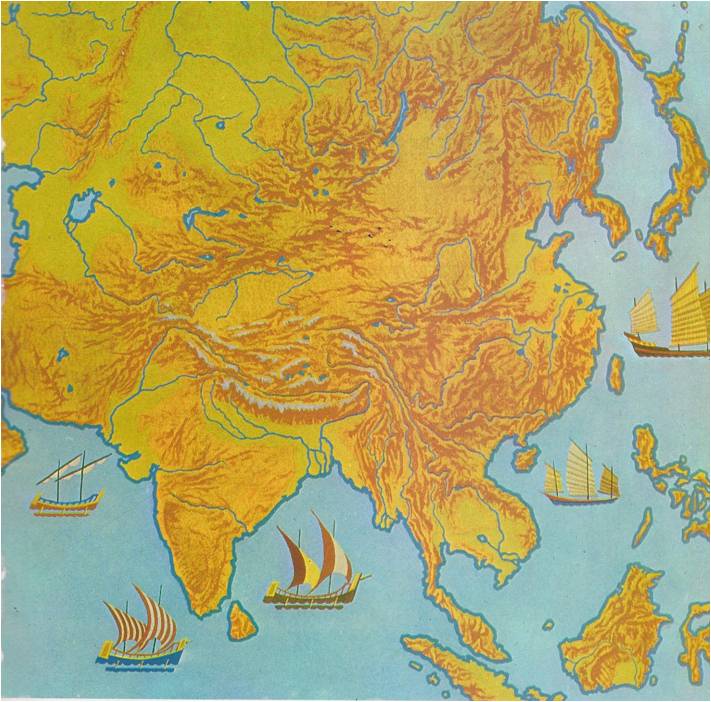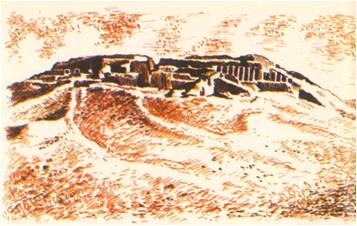Two hundred years before Columbus discovered America, a certain Marco Polo told strange, exciting stories to his friends and neighbours in Venice, a city in northern Italy. He had travelled, he said, to distant lands in Asia and had become rich. Europeans at that time had some general knowledge of eastern Asia and of its products, but Polo furnished detailed and colourful descriptions of magnificent cities, of strange customs and of powerful rulers who owned many palaces and lived in unheard of luxury. Marco Polo had visited the court of the khan, or ruler, of an empire that included most of east Asia as well as great islands in the Pacific and Indian Oceans. Polo had been made a public official. He had been sent on errands to the cold wastes of present day Siberia and the green Spice Islands where it was always warm. He had seen civilizations of many kinds — some primitive, some more magnificent than those in Europe. Marco Polo’s stories were so amazing that not until long after his death did most people believe them. “How,” thought Europeans, “could Asians have travelled so far on the long road from savagery without our help?” Today we know that Marco Polo’s stories were true, atleast in all important respects. We know that while Egyptians were building their pyramids and the Sumerians their temple towers in Mesopotamia, civilization was growing in India. We know also that while the Greeks and Romans were creating “the glory that was Greece and the grandeur that was Rome,” the Chinese were developing their own civilization and way of life. You will not find the empire of Alexander or the Roman Empire on a modern map of the world, as you know, but India and China still exist. Many changes have taken place …
Read More »The United Nations and the End of Colonialism 1946 -1965
Even before the Korean War, the United Nations had proved that it could take effective action to control serious conflicts. It first took such action in the conflict over Palestine. During World War I, the British had ousted the Turks from Palestine. When the war was over, the League of Nations placed that land under the authority of Britain. The British then issued the famous Balfour Declaration, which promised the Jewish people that Palestine would someday become their homeland, but the Arabs of Palestine and the surrounding countries strongly objected to this and year after year passed without the British making good their promise. During and after World War II, Britain refused to allow Jewish refugees from Europe to enter Palestine. In 1946 Jewish terrorists began to stage raids against the British army and a year later Britain turned the Palestine problem over to the United Nations. The General Assembly set up a special committee to investigate the situation and make recommendations and several months later the committee delivered its report. It recommended that Palestine be divided into two independent states, one Arab and one Jewish. Although the Arabs, who formed a majority of the people in Palestine, said they would never allow the existence of a Jewish state, the General Assembly approved the committee’s report. Britain was expected to carry out and enforce the recommendations. Instead, the British suddenly left Palestine in the spring of 1948 and war broke out between the Arabs and the Jews. The Palestinian Arabs were supported by troops from the surrounding countries of Jordan, Syria, Iraq and Egypt, but the Jewish army, which included many hardened veterans of World War II, won battle after battle. With every victory, the Jews added to the territory originally granted them by the United Nations special committee. Most …
Read More »The Coming of Islam A.D. 711 – 1526
IN 711‚ when other Moslem forces were invading distant Spain, Arab soldiers fought their way to the mouth of the Indus River and captured the area called Sind. There they stopped. Nearly three centuries passed before Moslems again menaced India. In 998, a Turk named Mahmud, the amir of Ghazni in Afghanistan, burst through the Khyber Pass with an army of Turkish horsemen to sweep across the Punjab in the first of seventeen raids. Not even the savage, pagan Huns had been as bloodthirsty as these civilized sons of Islam. They hated the Hindus with a special hate. Believing in one God and in the equality of all men, they abominated the Indians for their countless gods and idols and their caste system. In a frenzy of righteousness they slew thousands upon thousands of Indians, smashing their temples and demolishing their cities. The Hindus fought back bravely, but their slow-footed elephants could not keep up with the Turks’ fast horses. They were hindered, too, by the custom which decreed that only members of the warrior caste could fight. Sometimes, when the Hindu defenders of a stronghold saw that the end was near, they carried out a dreadful rite called jauhur. They placed their wives and children on top of a huge pile of wood and set fire to it. Then, as their families were burned alive, they marched forth from the gates, carrying their swords, to meet certain death. The fearful raids of Mahmud “the imagebreaker” were followed by a large-scale Moslem invasion toward the end of the next century. In 1191, Mohammed Ghori, an Afghan not only raided India but occupied it. By destroying Buddhist universities and massacring their priests, he wiped out Buddhism in the land where it began. Soon he controlled most of the north. When a …
Read More »India: A Thousand Years of History A. D. 1 – 710
UNTIL 1947, when the Moslem state of Pakistan was carved out of its western and eastern corners, the entire triangle of land that points south from the Himalaya Mountains into the Indian Ocean was known as India. Geographers call this huge land mass a subcontinent, because it is almost completely cut off from the rest of the continent of Asia. The Himalayas on its northern frontier form a continuous barrier of rock, the highest in the world. “MOTHER GANGES” From the southern slopes of the Himalayas, two great rivers run down to the ocean. The valley of the Indus River, on the west, is mainly desert; overlooking it are the only breaks in the Himalayan wall, the Khyber Pass and the Bolan Pass. The valley of the Ganges River, on the east, is a broad, fertile plain. Indians consider this river holy and call it “Mother Ganges.” Together, the Indus and Ganges Valleys make up North India. South of the Ganges Plain rise the Vindhya Mountains. To the south stretches a very large region of hilly uplands, called the Deccan. At its western and eastern edges the Deccan drops suddenly to coastal plains, forming long mountain walls called Ghats. The Vindhyas, the Deccan, the Ghats and the strips of lowland along the coasts make up South India. INVADERS FROM THE NORTH Geography influences history. This is particularly true of India — so much so, in fact, that North and South India have really had two separate histories. From earliest times, the people in both parts of the country were mostly poor farmers, living in villages. They shared the beliefs of the Hindu religion. Hinduism taught them that life was only a dream, they paid little attention, north or south, to the events that took place in their lifetimes. Otherwise, however, …
Read More »Christian Knights and Mongol Horsemen A. D. 099-1404
THROUGHOUT THE eleventh century, the divided Arab Empire became weaker in all its parts. Meanwhile, the Christian lands to the north became stronger. Adventures from northern France snatched Sicily and Southern Italy from the Arabs. The pope called on the rulers of Europe for a united Christian attack on the Moslems. By the end of the century, European knights in chain-mail armour were streaming into Syria by land and sea, determined to recapture the holy places of their religion. This campaign was the first of many. The Crusades dragged on for two centuries, with long periods of peace coming between bouts of fighting. Christian kings and noblemen carved small states out of Moslem territory, only to lose them. In 1099, Frankish troops seized Jerusalem, the Christians’ holy city, and made it the capital of a kingdom. In 1187 Saladin reconquered the country for Islam. After the Moslems forced the last Crusaders to leave Syria in 1291, only the island of Cyprus remained under the Christian flag. So, in the end, although the Crusades did not change the balance of power between Christianity and Islam, they left behind bitter memories which were to poison Moslem-Christian relations for centuries. Not all of the results were bad, however. The Crusaders, who came to the Near East convinced of their own superiority, found that their despised enemies knew more than they did about a great many things. They took the knowledge they had gained home to Europe. The brave deeds of the warriors on both sides gave rise to thousands of poems, songs and tales which enriched the literatures of Europe and Islam. The Christian heroes included two kings — Richard the Lion Hearted of England and Louis IX of France, who was made a saint. Among the Moslem heroes, the most famous were …
Read More »Civilization comes to India 3500 B.C to 200 B.C.
For thousands of years during the Stone Age, only scattered groups of people had lived in India. With only the simplest tools of bone, wood and stone, they hunted and gathered food. Cut off from other peoples by the mountain and the sea, the first Indians made few advances in their primitive way of life. Then, sometime between 3500 B. C., new settlers began to appear along the Indus River Valley in northwestern India, a region that would be called West Pakistan thousands of years later. It seems almost certain that these newcomers were from the mountains and plateaus to the northwest, the modern lands of Iran and Afghanistan. When they arrived, the new commers were already able to make pottery, to farm and to raise animals. Most likely too, some of them knew of the cities far to the west, on the plains of Mesopotamia. From those more advanced cities, the Indus valley people learned about new objects, such as copper and bronze tools. They also heard tales about how those distant peoples controlled the river’s water, or how they scratched signs in clay tablets to record words. However much they may have borrowed, the Indus Valley people worked out their own ways. By 2500 B. C., a distinctive civilization had begun to develop along the Indus River. The river itself played an important part in this civilization. Sometimes it flooded so badly that it wiped out villages and fieldworks, or even changed its course entirely. Usually however, it overflowed just enough to leave a rich soil for each season’s crops and the people worked together to take advantage of it. The river also made it easy for the various settlements to exchange goods and ideas. The People of the Indus Of the dozens of villages, two soon grew …
Read More »





